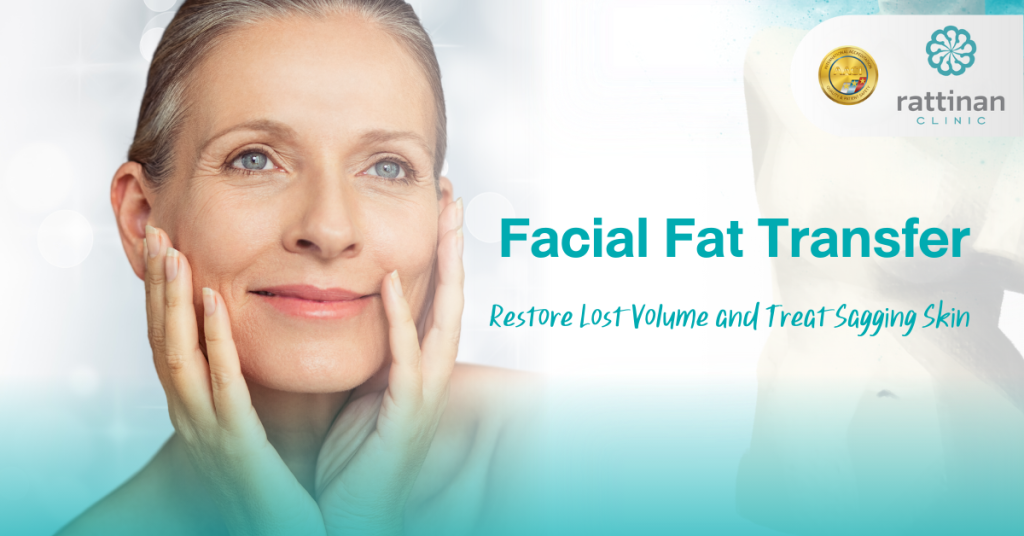As we age, loss of facial volume becomes more noticeable. This can lead to hollow temples, sunken cheeks, and deeper lines around the eyes and mouth. Flattened cheeks and a less youthful appearance are common concerns. While genetics play a role in facial structure—some people have prominent cheekbones and chins, while others have softer, rounder features—volume loss due to ageing is now widely recognised as a key factor in facial ageing.
Whether your concern is age-related volume loss or natural facial structure, there are effective solutions. Facial fat transfer, facial implants, and dermal fillers can restore volume, enhance facial contours, and create a youthful, refreshed appearance.
What Is Facial Fat Transfer?
Facial fat transfer, also known as fat grafting, is a natural, minimally invasive surgical procedure that restores lost facial volume. Fat is harvested from areas with excess fat (such as the abdomen or thighs), processed, and then injected into areas of the face that need volume.
This procedure delivers natural-looking results with a low risk of rejection, as your body’s own fat is used. Common areas treated include:
- Nasolabial folds (lines between the nose and mouth)
- Marionette lines (lines between the mouth and chin)
- Hollow cheeks
- Sagging jawlines
- Under-eye hollows
Facial Implants for Contouring and Definition
For younger patients seeking more defined features, facial implants are a popular choice. Implants are surgically placed in areas like the cheeks or chin to enhance shape and volume. This option provides a permanent solution for those desiring a stronger facial contour.
Who Is a Good Candidate for Facial Fat Transfer or Implants?
During your consultation, your doctor will assess whether you are a suitable candidate. In general:
- Candidates should be in good health with realistic expectations
- For facial fat transfer, patients need to have enough fat available for harvesting and be at a stable weight
- Dermal fillers are low-risk and typically do not have strict eligibility requirements
Selecting an experienced medical team is key. Look for licensed specialists with proven expertise, like those at Rattinan Clinic, to ensure the best results.
How Facial Fat Transfer Works: Step-by-Step
Facial fat transfer involves three key steps:
1. Fat Harvesting
Fat is carefully removed from donor areas such as the abdomen, thighs, or buttocks. If combined with a facelift, fat from the neck may also be used. High-quality fat is selected for better survival rates and optimal results.
2. Fat Processing
The harvested fat contains oil, blood, and other substances that need to be removed to improve fat viability. Processing techniques include:
- Sedimentation: Fat is separated by gravity. This method is gentle but time-consuming.
- Centrifugation: Fat is spun at high speeds to separate impurities. This method is quick but must be carefully controlled.
- Washing and Filtering: Fat is rinsed with saline and filtered through gauze for a fast and cost-effective option.
3. Fat Injection
The purified fat is placed into small syringes and carefully injected into the target areas. A tiny incision is made to insert a cannula, ensuring minimal scarring. Fat is injected slowly and evenly to avoid damage and ensure a smooth, natural appearance.
Recovery After Facial Fat Transfer or Implants
Facial Fat Transfer Recovery
- Most patients take 7-10 days off work and social activities.
- Swelling improves within a few weeks, with final results visible after 6 months.
- Some results are noticeable within days after surgery.
Facial Implant Recovery
- Expect at least one week of downtime.
- Exercise should be avoided for several weeks.
- Swelling can obscure results initially, but it typically subsides within 6 months, revealing the final contour.
Why Choosing the Right Clinic Matters
Facial fat transfer and implant surgery require skill and precision. If not performed by an experienced surgeon, complications can occur, including:
- Bruising and swelling (oedema)
- Overcorrection or undercorrection
- Scarring or tissue irregularities
- Fat embolism (rare but serious)
Choosing a reputable clinic like Rattinan Clinic ensures:
- Board-certified surgeons
- Advanced equipment and techniques
- Proven safety protocols
This reduces the risk of complications and delivers the best possible results.
Book Free Consultation
If you’re considering facial fat transfer or facial implants, schedule a consultation with our expert team. Rattinan Clinic offers safe, advanced procedures tailored to your individual needs.
- Restore volume
- Enhance facial contours
- Achieve a more youthful look



Our Expert Medical Contributors are licensed doctors and specialists who ensure every article is accurate, trustworthy, and easy to understand. Guided by our commitment to safety, care, and confidence, they provide expert insights to help patients make informed decisions. At Rattinan, we believe that knowledge is the first step to transformation.